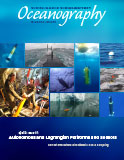Feddersen, F., M. Olabarrieta, R.T. Guza, D. Winters, B. Raubenheimer, and S. Elgar. 2016. Observations and modeling of a tidal inlet dye tracer plume. Journal of Geophysical Research 121:7,819–7,844, https://doi.org/10.1002/2016JC011922.
Lucas, A.J., P.J.S. Franks, and C.L. Dupont. 2011. Horizontal internal-tide fluxes support elevated phytoplankton productivity over the inner continental shelf. Limnology and Oceanography: Fluids and Environments 1:56–74, https://doi.org/10.1215/21573698-1258185.
Lucas, A.J., and R.M. Kudela. 2015. The fine-scale vertical variability of a wastewater plume in shallow, stratified coastal waters. Estuarine, Coastal, and Shelf Science 186:183–197, https://doi.org/10.1016/j.ecss.2015.08.010.
Lucas, A.J., J.D. Nash, R. Pinkel, J.A. MacKinnon, A. Tandon, A. Mahadevan, M.M. Omand, M. Freilich, D. Sengupta, M. Ravichandran, and A. Le Boyer. 2016. Adrift upon a salinity-stratified sea: A view of upper-ocean processes in the Bay of Bengal during the southwest monsoon. Oceanography 29(2):134–145, https://doi.org/10.5670/oceanog.2016.46.
Lucas, A.J., G.C. Pitcher, T.A. Probyn, and R.M. Kudela. 2014. The influence of diurnal winds on phytoplankton dynamics in a coastal upwelling system off southwestern Africa. Deep Sea Research Part II 101:50–62, https://doi.org/10.1016/j.dsr2.2013.01.016.
Omand, M.M., I. Cetinić, and A.J. Lucas. 2017. Using bio-optics to reveal phytoplankton physiology from a Wirewalker autonomous platform. Oceanography 30(2):128–131, https://doi.org/10.5670/oceanog.2017.233.
Omand, M.M., J.J. Leichter, P.J.S. Franks, R.T. Guza, A.J. Lucas, and F. Feddersen. 2011. Physical and biological processes underlying the sudden surface appearance of a red tide in the nearshore. Limnology and Oceanography 56:787–801, https://doi.org/10.4319/lo.2011.56.3.0787.
Pinkel, R., M.A. Goldin, J.A. Smith, O.M. Sun, A.A. Aja, M.N. Bui, and T. Hughen. 2011. The Wirewalker: A vertically profiling instrument carrier powered by ocean waves. Journal of Atmospheric And Oceanic Technology 28:426–435, https://doi.org/10.1175/2010JTECHO805.1.
Rainville, L., and R. Pinkel. 2001. The Wirewalker: An autonomous wave-powered vertical profiler. Journal of Atmospheric And Oceanic Technology 18:1,048–1,051, https://doi.org/10.1175/1520-0426(2001)018<1048:WAAWPV>2.0.CO;2.

